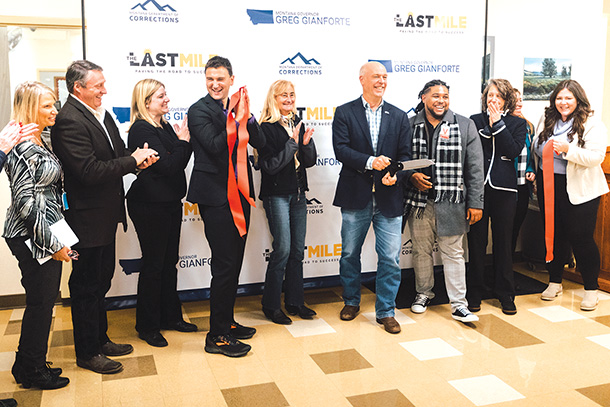
Executives of the non-profit organization, The Last Mile (TLM), joined key figures of the Montana Department of Corrections and Governor Greg Gianforte to formally launch TLM’s workforce development program at Montana State Prison (MSP) on October 25, 2022. (Courtesy photo)
by Michael J. Marino
Montana State Prison (MSP) recently launched a new workforce training program that helps incarcerated individuals prepare for reentry into society by teaching them in-demand job skills and offering post-release support. Provided by non-profit organization, The Last Mile (TLM), the program touts a zero percent recidivism rate among its graduates.
Officials with the state Department of Corrections (DOC) and Governor Greg Gianforte joined TLM executives for a ribbon cutting ceremony on October 25, followed by a tour of the program’s new classroom.
The Last Mile, founded in 2010, provides technology training for modern jobs to incarcerated people, according to its website. For example, TLM’s Web Development Program teaches students how to “create websites and web applications using industry standard technology such as HTML, CSS, JavaScript,” and many others. The organization’s mission is to “disrupt the system of mass incarceration in the United States,” through its work in “prison education, transitional support and workforce reentry.”
With growing concern among Yellowstone County residents regarding problems like jail overcrowding and public safety, TLM stands to add another solution to a host of other recent efforts to reform Montana’s justice system. It won’t happen all at once, though, said TLM Executive Director Sydney Heller in an interview with YCN.
“There’s a propensity,” said Heller, “for people to want an immediate change to what they see happening,” which can make seeing the bigger picture more difficult. He explained, “If people see the jail is overcrowded… or crime is high in a particular neighborhood, then they want someone to do something that will immediately alleviate that problem.” In turn, this “prevents people from identifying the real problem,” which Heller stated, is “by definition, not going to be solved overnight.”
Perhaps not an overnight solution, but according to data from TLM, a viable one. The organization’s latest Annual Report indicated 86% of students who graduate from TLM are gainfully employed after their release, and 90% go on to continue their education upon reentering society. This data is based on the program’s 855 participants who are now returned citizens, meaning they graduated and are no longer incarcerated.
Montana’s DOC is still in the process of researching how programs like workforce training and diversion affect recidivism rates; however, a 2017 report in the Criminal Justice Policy Review found that “successful clients maintained lower recidivism rates,” and such programs have “positive impacts” on participants.
Heller also discussed TLM’s efforts to humanize the way in which people think and talk about incarcerated folks. “It’s really easy to totally lose sight of any humanity in the situation,” he said, when one uses terms such as “criminal,” “offender,” or “prisoner.” These types of black-and-white labels perpetuate negative stigmas, said Heller. Instead, he suggests “people first” language like “justice-impacted individual;” and in lieu of describing a person released from prison as an “ex-convict,” a “returned citizen.”
TLM is now, with the addition of Montana, operating in six states and 16 different facilities, and Heller called the growth “mostly organic.” He said members of Montana DOC visited TLM shortly after its inception in 2010 and expressed the state’s desire to partner with them.
Concluded Heller, “We’re excited for the opportunity to bring TLM to Montana.”
“It’s a great day for Montana,” said Gov. Gianforte at the Oct. 25 ribbon cutting. The Governor expressed confidence that TLM will “open doors to opportunity for graduates, reduce recidivism in our communities, and make Montana healthier and stronger.”
DOC Director, Brian Gootkin, said the Department is “deeply grateful” to be able to offer the TLM program.
To read data and statistics regarding correctional measures in Montana, visit www.cor.mt.gov and click on “DOC Data.”

